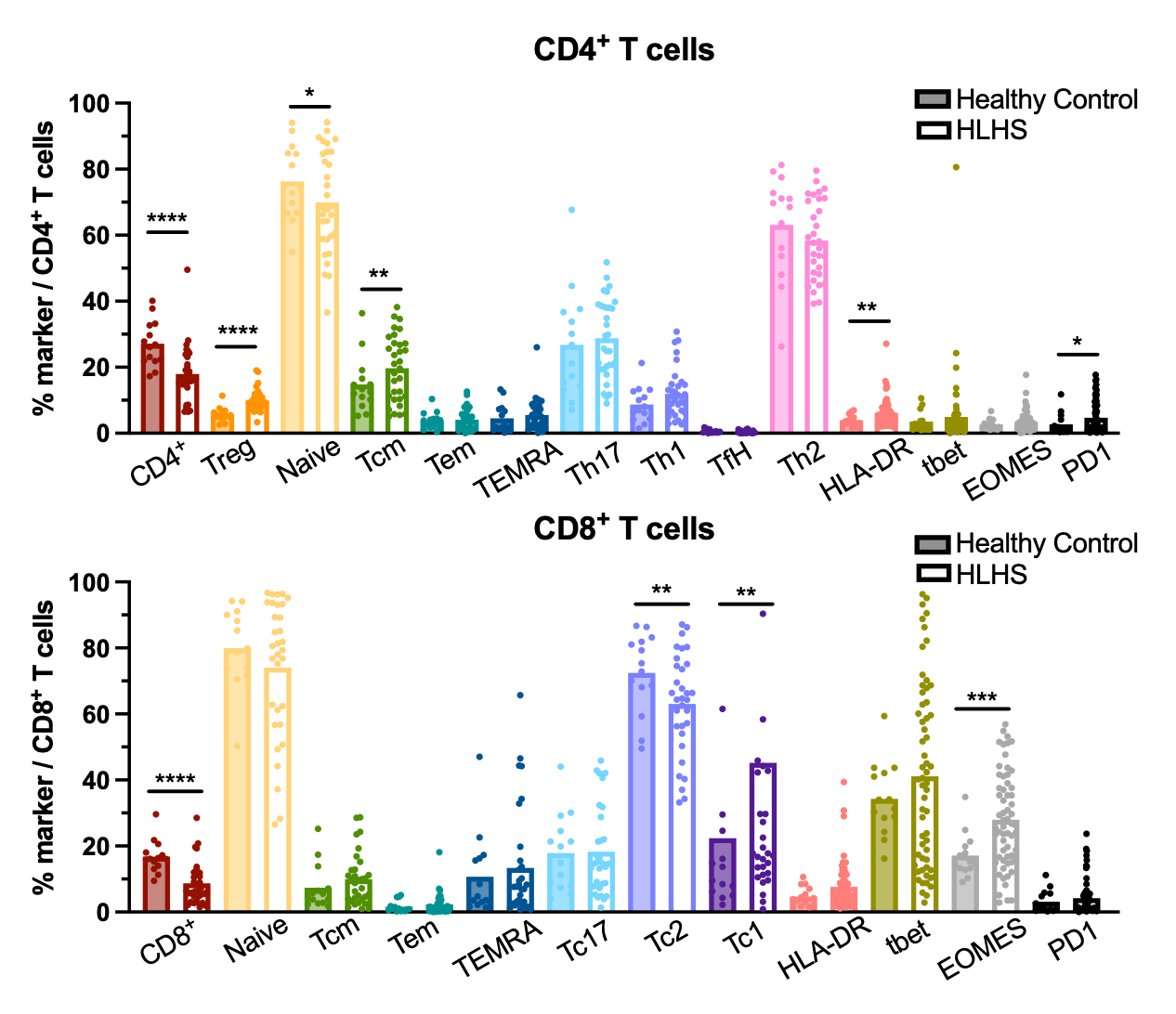Final ID: Sa2009
Immunologic Insights: Activated and Exhausted Circulating T-Cell Phenotype in Hypoplastic Left Heart Syndrome (HLHS)
Abstract Body (Do not enter title and authors here): Background. While staged surgical palliation for infants born with hypoplastic left heart syndrome (HLHS) has enabled many patients to survive a previously fatal condition, there is now a growing population of HLHS children and young adults who experience significant co-morbidities and mortality secondary to their palliated physiology. Abnormalities of the immune system, including T-cell lymphopenia, have been documented in HLHS patients. However, the impact of altered T-cell homeostasis remains ill-defined.
Hypothesis. Both intrinsic and acquired alterations in T-cell sub-populations results in T-cell activation/exhaustion and a pro-inflammatory phenotype.
Methods. Peripheral T-cell sub-populations and activation/inhibition markers were quantified in HLHS (n=32, median age 1.65 years, range 0-13.2 years) and healthy, pediatric controls (n=14, median age 4.55 years, range 0.2-15.1 years) by mass cytometry (Helios Cytometry Time Of Flight, CyTOF). Comparison between HLHS and controls was performed by unpaired t-test or Mann-Whitney, based on normality.
Results. In HLHS subjects, circulating CD4+ and CD8+ populations are significantly decreased (p<0.001) compared to control. The proportions of CD4+HLA-DR+ (p<0.05) and CD8+EOMES+ (p<0.01) T cells are increased in HLHS. HLHS CD8+TC1+ populations are increased (p<0.05) while HLHS CD8+TC2+ (p<0.05) populations are decreased compared to controls. Notably, there is an increase in CD4+ regulatory T cells in HLHS subjects (p<0.001).
Conclusions. Immunoprofiling of peripheral T-cell populations suggests that abnormalities extend beyond a decrease in T-cell numbers: HLHS T cells demonstrate an activated and exhausted phenotype, which may impact development of co-morbidities in this population. Additional investigations are required to delineate the functional consequences of this unique HLHS immunophenotype.
Hypothesis. Both intrinsic and acquired alterations in T-cell sub-populations results in T-cell activation/exhaustion and a pro-inflammatory phenotype.
Methods. Peripheral T-cell sub-populations and activation/inhibition markers were quantified in HLHS (n=32, median age 1.65 years, range 0-13.2 years) and healthy, pediatric controls (n=14, median age 4.55 years, range 0.2-15.1 years) by mass cytometry (Helios Cytometry Time Of Flight, CyTOF). Comparison between HLHS and controls was performed by unpaired t-test or Mann-Whitney, based on normality.
Results. In HLHS subjects, circulating CD4+ and CD8+ populations are significantly decreased (p<0.001) compared to control. The proportions of CD4+HLA-DR+ (p<0.05) and CD8+EOMES+ (p<0.01) T cells are increased in HLHS. HLHS CD8+TC1+ populations are increased (p<0.05) while HLHS CD8+TC2+ (p<0.05) populations are decreased compared to controls. Notably, there is an increase in CD4+ regulatory T cells in HLHS subjects (p<0.001).
Conclusions. Immunoprofiling of peripheral T-cell populations suggests that abnormalities extend beyond a decrease in T-cell numbers: HLHS T cells demonstrate an activated and exhausted phenotype, which may impact development of co-morbidities in this population. Additional investigations are required to delineate the functional consequences of this unique HLHS immunophenotype.
More abstracts on this topic:
Aging-Associated Protein Medin Induces Human Coronary Artery Endothelial Proinflammatory and Prothrombotic Activation
Karamanova Nina, Morrow Kaleb, Maerivoet Alana, Madine Jillian, Li Ming, Migrino Raymond
Myeloid cell TRIM59 deficiency promotes experimental abdominal aortic aneurysmsXu Baohui, Tsao Philip, Dalman Ronald, Yan Dongmei, Ikezoe Toru, Samura Makoto, Ye Jiayu, Jin Zheng, Ai Wenjia, Ju Junjie, Fang Weirong

